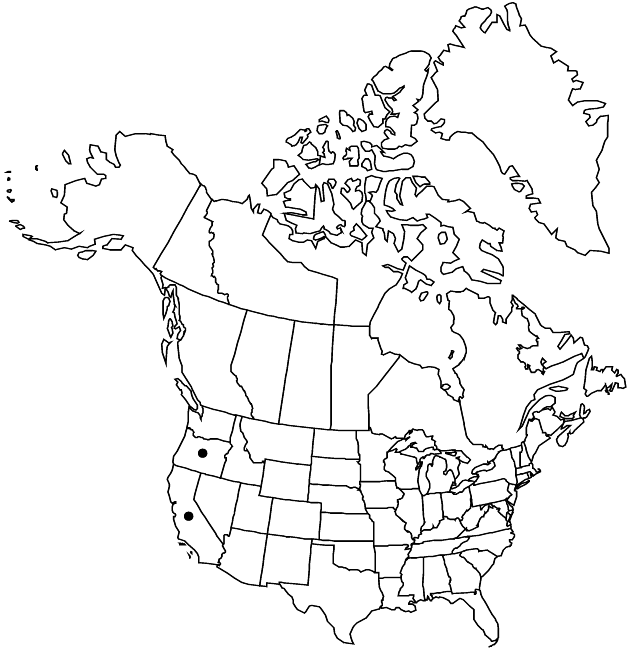Difference between revisions of "Matricaria occidentalis"
Bull. Calif. Acad. Sci. 2: 150. 1886.
FNA>Volume Importer |
imported>Volume Importer |
||
| (6 intermediate revisions by 2 users not shown) | |||
| Line 8: | Line 8: | ||
}} | }} | ||
|common_names=Valley mayweed | |common_names=Valley mayweed | ||
| + | |special_status={{Treatment/ID/Special_status | ||
| + | |code=F | ||
| + | |label=Illustrated | ||
| + | }}{{Treatment/ID/Special_status | ||
| + | |code=E | ||
| + | |label=Endemic | ||
| + | }} | ||
|basionyms= | |basionyms= | ||
|synonyms={{Treatment/ID/Synonym | |synonyms={{Treatment/ID/Synonym | ||
|name=Chamomilla occidentalis | |name=Chamomilla occidentalis | ||
|authority=(Greene) Rydberg | |authority=(Greene) Rydberg | ||
| + | |rank=species | ||
}} | }} | ||
|hierarchy=Asteraceae;Asteraceae tribe Anthemideae;Matricaria;Matricaria occidentalis | |hierarchy=Asteraceae;Asteraceae tribe Anthemideae;Matricaria;Matricaria occidentalis | ||
| Line 27: | Line 35: | ||
|elevation=0–2400 m | |elevation=0–2400 m | ||
|distribution=Calif.;Oreg. | |distribution=Calif.;Oreg. | ||
| − | |discussion=<p>E. McClintock (1993b) reported Matricaria occidentalis as being used as a substitute for chamomile. In California, the species is found in the Coast Ranges to the South Coast, in parts of the San Joaquin Valley, and in the High Cascade, Sierra Nevada, and Desert Ranges and surrounding areas. Although listed as secure, the species appears to have been eradicated from some counties in California and its range may be shrinking due to disappearance of its habitat.</p> | + | |discussion=<p>E. McClintock (1993b) reported <i>Matricaria occidentalis</i> as being used as a substitute for chamomile. In California, the species is found in the Coast Ranges to the South Coast, in parts of the San Joaquin Valley, and in the High Cascade, Sierra <i>Nevada</i>, and Desert Ranges and surrounding areas. Although listed as secure, the species appears to have been eradicated from some counties in California and its range may be shrinking due to disappearance of its habitat.</p> |
|tables= | |tables= | ||
|references= | |references= | ||
| Line 36: | Line 44: | ||
-->{{#Taxon: | -->{{#Taxon: | ||
name=Matricaria occidentalis | name=Matricaria occidentalis | ||
| − | |||
|authority=Greene | |authority=Greene | ||
|rank=species | |rank=species | ||
| Line 50: | Line 57: | ||
|publication title=Bull. Calif. Acad. Sci. | |publication title=Bull. Calif. Acad. Sci. | ||
|publication year=1886 | |publication year=1886 | ||
| − | |special status= | + | |special status=Illustrated;Endemic |
| − | |source xml=https:// | + | |source xml=https://bitbucket.org/aafc-mbb/fna-data-curation/src/2e0870ddd59836b60bcf96646a41e87ea5a5943a/coarse_grained_fna_xml/V19-20-21/V19_942.xml |
|tribe=Asteraceae tribe Anthemideae | |tribe=Asteraceae tribe Anthemideae | ||
|genus=Matricaria | |genus=Matricaria | ||
Latest revision as of 19:57, 5 November 2020
Annuals, 8–45(–70) cm; not notably aromatic. Stems 1–5+, usually erect, sometimes ascending, simple or branched mostly distally, sometimes proximally (then ascending). Leaf blades 1560(–80) × 5–28 mm. Heads discoid, 1–15+, borne singly or in open, corymbiform arrays. Peduncles 1–56(–90) mm (glabrous or villosulous near heads, bracts 0–3, simple or 1-pinnate). Involucres 3.5–4.5 mm. Phyllaries 25–55+ in 3–4 series, margins erose. Receptacles 4.5–6.6 mm, rounded to obtuse or ± acute. Ray florets 0. Discs ovoid to hemispheric, 5.5–12.5 × 6–14 mm. Disc florets 400–750+; corollas greenish yellow, 1.2–1.7 mm (sparsely glandular), lobes 4. Cypselae tan to brownish, obtriangular-obconic (angular, abaxial faces rounded, adaxial faces slightly convex), 1–1.5 mm, ribs white (2 abaxial, 2 lateral, each with reddish brown mucilage gland in distal 1/2, glands expanding into lobes, 1 adaxial, usually obscure, sometimes with a gland), faces not glandular; pappi coroniform, lobed (lobes 2, spreading, abaxio-lateral, ± obtuse to rounded). 2n = 18.
Phenology: Flowering spring–summer, fruiting summer–fall.
Habitat: Undisturbed alkali flats, vernal pools, edges of salt marshes
Elevation: 0–2400 m
Discussion
E. McClintock (1993b) reported Matricaria occidentalis as being used as a substitute for chamomile. In California, the species is found in the Coast Ranges to the South Coast, in parts of the San Joaquin Valley, and in the High Cascade, Sierra Nevada, and Desert Ranges and surrounding areas. Although listed as secure, the species appears to have been eradicated from some counties in California and its range may be shrinking due to disappearance of its habitat.
Selected References
None.

